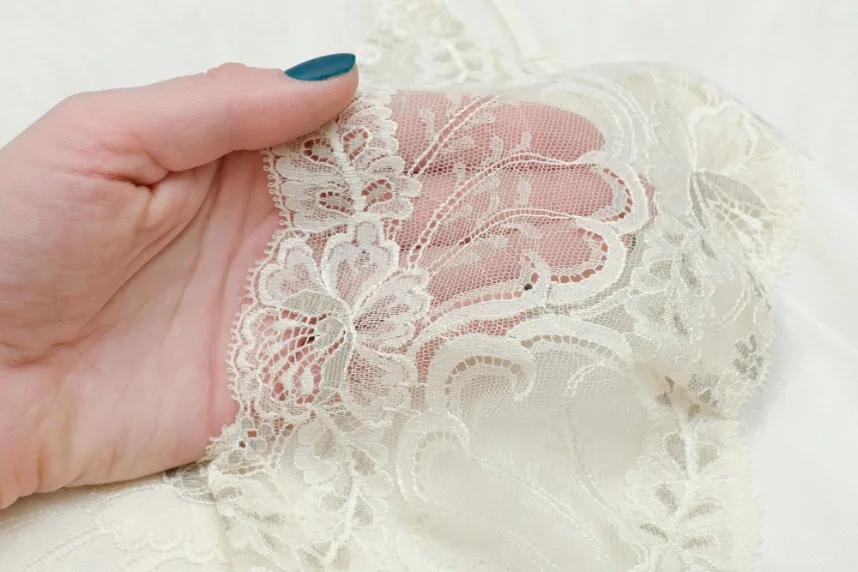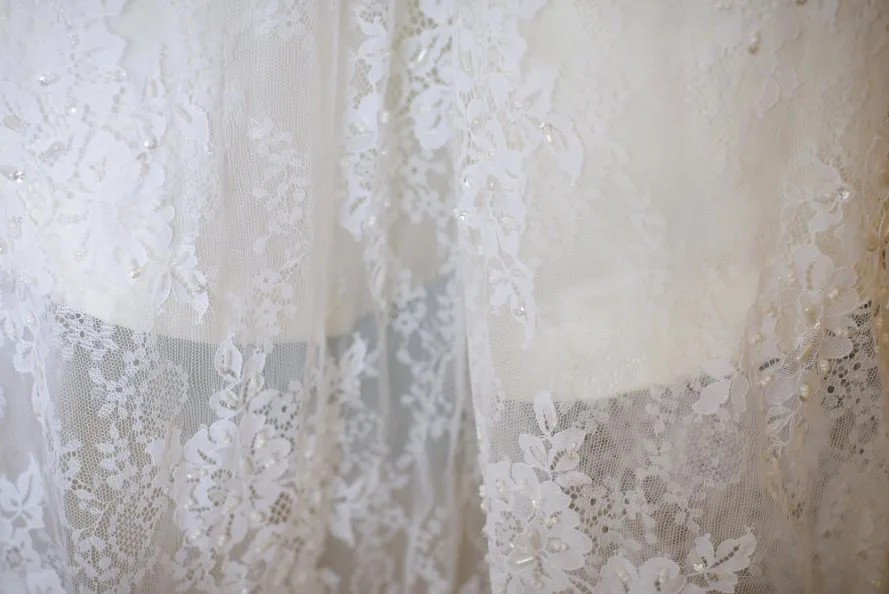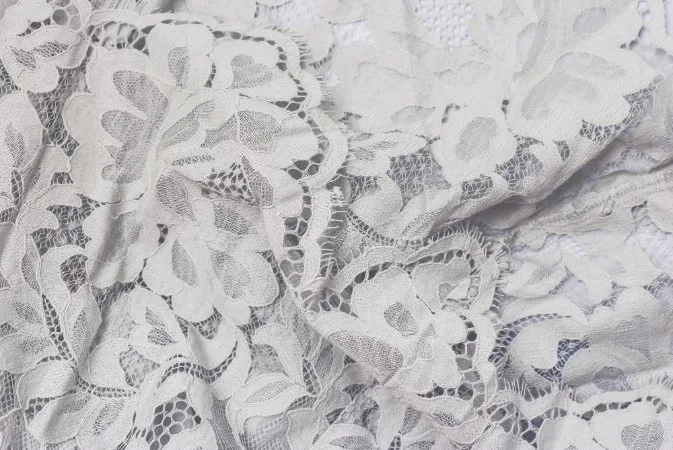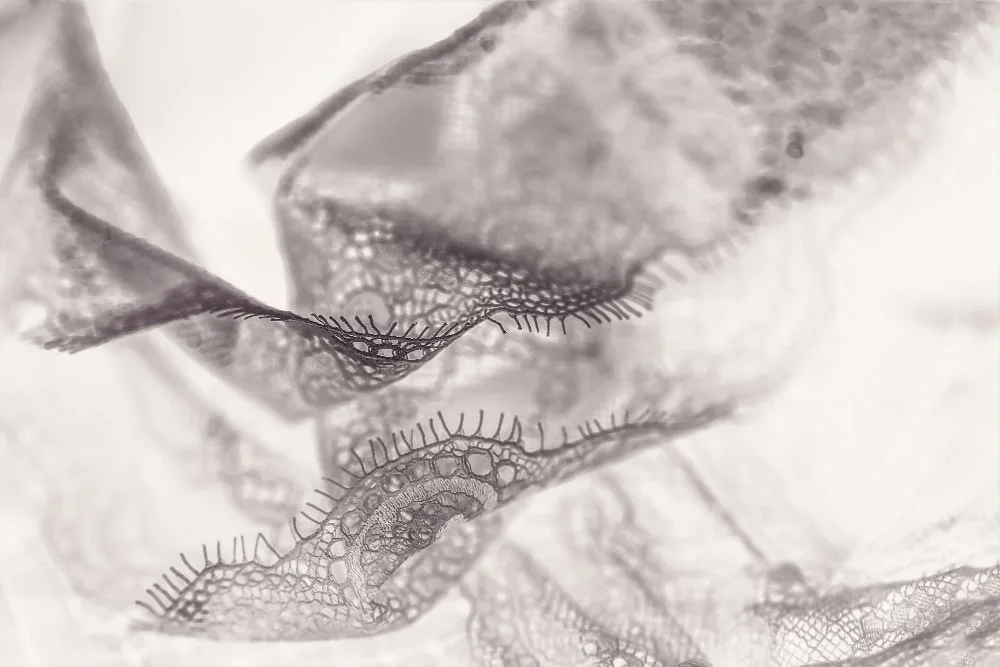Discover the intricate world of hand-crafted luxury that takes 40+ hours to create just one yard
Table of Contents
- What is Leavers Lace Fabric?
- History and Origins
- The Intricate Production Process
- Unique Features and Design Elements
- Types and Materials
- Current Industry Crisis
- Applications in Fashion and Lingerie
- Sustainability and Environmental Impact
- Complete Care and Preservation Guide
- Pricing and Investment Value
- How to Buy Authentic Leavers Lace
- Frequently Asked Questions
What is Leavers Lace Fabric?

Authentic Leavers lace fabric showcasing the intricate patterns and exceptional craftsmanship that define this luxury textile
Leavers lace represents the pinnacle of machine-made lace craftsmanship, so intricate that a single yard can cost more than $150 and requires over 40 hours of meticulous work. This extraordinary textile accounts for less than 1% of global lace production, yet it dominates luxury lingerie boutiques and haute couture runways worldwide.
Unlike mass-produced alternatives or even other high-quality lace fabrics, Leavers lace emerges from thousands of threads woven simultaneously on antique looms dating back to the 1800s. Master artisans layer cotton, metallic yarns, and polyester into floral motifs so precise they resemble hand-painted artwork.
What Makes Leavers Lace Special?
The magic lies in its construction. While other laces have patterns embroidered onto existing fabric, Leavers lace creates the design and background simultaneously. This fusion produces signature details like corded edges and semi-sheer backgrounds that simply cannot be replicated by modern manufacturing methods.
What is the Difference Between Lace and Leavers Lace?
The distinction between regular lace and Leavers lace is like comparing a printed photograph to an original painting. Standard Chantilly lace and Guipure lace are often created using modern knitting machines or have decorative patterns applied to pre-existing mesh.
Regular Lace
- Machine knitted background
- Uniform mesh gaps
- Surface embroidery
- Mass production capable
- $5-20 per yard
Leavers Lace
- Twisted thread construction
- Irregular, artistic mesh
- Integrated patterns
- Limited artisan production
- $50-200+ per yard
History and Origins of Leavers Lace
In 1813, framesmith John Levers revolutionized textile production from his workshop in Nottingham by adapting John Heathcoat’s net-making machine. His modifications birthed a lace-making technique that would dominate luxury markets for over two centuries. The innovation transformed simple threads into complex patterns without requiring hand embroidery.
From Nottingham’s Lace Market to Global Recognition
By the 1890s, Nottingham’s historic Lace Market district buzzed with over 25,000 artisans working across hundreds of businesses. This quarter-mile area became the global epicenter of high-end textile production, exporting famous Nottingham lace across Europe, North and South America, and as far as Egypt and India.
Queen Victoria’s 1897 city status grant recognized the industry’s economic impact, cementing Britain’s leadership in luxury textiles. The spelling “Leavers” emerged gradually as the technique spread worldwide, taking roughly 100 years for the ‘a’ to become standard, honoring the method’s evolution beyond its inventor.
Modern Production Centers
While Britain pioneered the craft, France’s Calais region now produces most authentic Leavers lace, known locally as “Dentelle de Calais.” Only Cluny Lace remains in the UK, with eight generations of the Mason family preserving traditional methods using Victorian machinery.
🚨 Industry Crisis Alert
Breaking: Cluny Lace, the UK’s last remaining Leavers lace manufacturer, faces “terminal closure” due to post-Brexit duty regulations and skilled worker shortages. After surviving over 200 years, this family business that created lace for Princess Diana and Kate Middleton’s wedding dresses is struggling with a £10,000 duty debt and the loss of traditional dyeing facilities.
The Intricate Production Process Behind Leavers Lace
Creating Leavers lace requires eight distinct specialists working in perfect harmony. From initial sketches to final quality checks, each step demands precision that modern automation simply cannot replicate.
The 8-Step Leavers Lace Creation Process
Drafter
Sketches the initial floral or geometric patterns on paper
Technical Drafter
Converts artwork into coded punch card instructions for the loom
Lacemaker
Sets up threads in precise order and position on the machine
Winder
Loads 3,000+ bobbins daily, ensuring consistent weight and tension
Machine Operation
Victorian-era looms weave patterns using punch card guidance systems
Tullist (Supervisor)
Monitors production like a conductor, halting for any thread irregularities
Inspector
Examines every inch under bright lights for flaws or irregularities
Hand Repair
Manually corrects any dropped stitches to preserve pattern continuity
Traditional Machines and Hand-Loaded Threads
The antique looms still use punch cards to guide designs – a 19th-century innovation that remains critical today. These massive machines, weighing up to 17 tons and standing 10 feet tall, contain 40,000 moving parts and can handle between 12,000 and 50,000 threads simultaneously.
Technical drafters convert floral motifs into coded instructions, mapping thousands of intersecting threads. Workers load each bobbin by hand, adjusting tension until patterns align perfectly. This process can take up to a month for complex designs.
Quality Control and Repairs
Inspectors examine every inch of finished lace under bright lights, hunting for irregularities. All repairs are done manually – a single dropped stitch requires hour-long corrections to preserve pattern continuity. Only 30% of output typically meets export standards, explaining the textile’s premium pricing.
Watch the fascinating production process of Leavers lace on traditional Victorian machinery
Discover the reasons behind the premium pricing of authentic French Leavers lace
Understanding Leavers Lace Fabric: Unique Features and Design Elements

The intricate handwoven details and irregular mesh patterns that distinguish authentic Leavers lace from machine-made alternatives
True artistry emerges when every thread contributes to the final masterpiece. Leavers lace stands apart through its fully integrated patterns – no surface embroidery, just meticulous weaving that merges motifs with the base material.
Handwoven Intricacy Versus Machine-Applied Patterns
While standard decorative materials often layer embellishments onto existing nets, Leavers lace creates floral details and geometric shapes simultaneously with the background. This fusion creates stronger edges and prevents fraying – a key advantage for delicate garments.
Authentic pieces reveal another telltale feature: irregular mesh gaps. Unlike uniform machine-made nets, Leavers lace displays intentional variations in spacing. This technique adds dimension, making rose petals appear to float above sheer foundations.
| Feature | Leavers Lace | Machine Lace | Hand Lace |
|---|---|---|---|
| Pattern Integration | Fully woven | Surface applied | Fully integrated |
| Mesh Consistency | Artistically irregular | Uniform | Irregular |
| Edge Quality | Corded, strong | Cut, may fray | Strong |
| Production Time | 40+ hours/yard | Minutes | 100+ hours/yard |
| Durability | Excellent | Moderate | Excellent |
What is Leavers Lace Made Of?
Leavers lace utilizes four distinct types of yarns, each serving a specific purpose in creating the final textile masterpiece. Understanding these materials helps explain both the fabric’s exceptional quality and its premium pricing.
Primary Materials and Construction
Egyptian Cotton
Long-staple cotton provides strength and natural breathability. Creates the foundational structure with superior drape qualities.
French Nylon
High-quality synthetic adds durability and subtle sheen. Allows for intricate pattern details without breaking.
Metallic Threads
Gold, silver, or copper accents create luxury finishes. Often used for highlighting pattern edges and special details.
Polyester Blends
Modern additions provide stretch and color stability. Maintains pattern integrity through multiple washes.
Thread Types in Production
The Leavers machine uses four specific thread categories:
- Heavy Warp Threads: Twisted in right and left directions for stability and pattern formation
- Brass Bobbin Yarns: Wound on special brass bobbins and compressed at 20 tons per square inch
- Skein Yarns: Create the gimping that outlines pattern details
- Beam Threads: Vertical threads that contribute to repeating pattern motifs
What is French Leavers Lace?
French Leavers lace, known as “Dentelle de Calais,” represents the current global standard for luxury lace production. After the decline of UK manufacturing, Calais became the primary center for authentic Leavers lace creation.
French producers maintain the same Victorian-era machinery and techniques while incorporating subtle innovations in thread treatment and pattern design. The region’s expertise has attracted luxury fashion houses like Dior, Chanel, and Hermès, who specifically request Calais-made lace for their couture collections.
The humid climate near the English Channel provides ideal conditions for thread handling, reducing breakage during the intricate weaving process. This environmental factor, combined with generations of skilled workers, explains why France now dominates this specialized market.
Learn to identify authentic French Leavers lace and understand what sets it apart from other lace types
Current Industry Crisis: The End of an Era
The Leavers lace industry faces its most challenging period since World War II. Multiple factors threaten the survival of this 200-year-old craft, creating urgent concerns about cultural heritage preservation.
Skills Shortage and Aging Workforce
Operating a Leavers machine requires a minimum three-year apprenticeship, with full mastery taking much longer. Charles Mason of Cluny Lace explains: “If we recruit anybody new, we have to train them from the beginning. The old hands have all gone.”
The newest Leavers machines are over 60 years old, with most dating to the late 19th century. No new machines have been manufactured since 1960, making maintenance expertise as rare as the operational skills.
Brexit Impact on UK Production
Post-Brexit trade rules have created devastating financial pressures. Cluny Lace must send finished products to France for dyeing (no UK facilities remain), then faces 8% import duties on the increased value when returning the goods.
This “double taxation” has resulted in a £10,000 debt that threatens the company’s survival after over 200 years of continuous operation. The irony is stark – domestic manufacturers cannot access the same logistics solutions available to foreign competitors.
Cultural Heritage at Risk
The Mason family has operated in textiles since the 1730s, representing nine generations of expertise. Their closure would mark the end of UK Leavers lace production and the loss of irreplaceable traditional knowledge.
Applications in Lingerie and Fashion

Luxury lingerie and couture fashion pieces featuring authentic Leavers lace craftsmanship
High-end designers consistently choose Leavers lace for its ability to elevate everyday garments into artistic statements. Its intricate patterns and structural integrity make it ideal for both intimate apparel and runway-worthy creations.
Luxury Lingerie and Royal Connections
French brand Marjolaine pairs 100% silk bases with meticulously woven Leavers lace for their nightwear collections. These pieces showcase how hand-finished edges transform simple chemises into heirlooms.
The fabric’s royal pedigree includes Princess Diana’s wedding dress and Kate Middleton’s bridal gown and bridesmaid dresses. Fashion houses like Burberry, Dior, Alexander McQueen, and Dolce & Gabbana regularly feature Cluny Lace in their collections.
Celebrities including Angelina Jolie, Vivienne Westwood, and Paloma Faith have been photographed wearing Leavers lace designs, cementing its status in contemporary luxury fashion.
Technical Applications by Garment Type
| Application | Width Range | Typical Use | Price Range |
|---|---|---|---|
| Bridal Veils | 4-10 inches | Edge trim | $15-25/yard |
| Lingerie Panels | 12-24 inches | Cup construction | $40-80/yard |
| Evening Gown Overlay | 45-57 inches | Full coverage | $120-200/yard |
| Couture Details | 6-18 inches | Accent pieces | $30-60/yard |
Modern Fashion Integration
Contemporary designers blend traditional Leavers lace with innovative materials to meet 21st-century demands. Stretch lace combinations maintain aesthetic appeal while providing modern comfort and support.
Recent innovations include combining delicate patterns with performance fabrics like moisture-wicking elastics. This fusion preserves the historical artistry while addressing contemporary functionality requirements in intimate apparel.
For those interested in related lace techniques, exploring Tambour lace or Alencon lace can provide additional context for understanding different lace production methods and their unique characteristics.
Sustainability and Environmental Impact
As fashion faces increasing scrutiny over environmental impact, Leavers lace presents a complex sustainability story. While traditional production methods avoid many modern textile industry problems, the craft faces challenges adapting to eco-conscious demands.
Environmental Advantages of Traditional Production
Leavers lace manufacturing offers several environmental benefits compared to fast fashion alternatives:
Sustainable Aspects
- Minimal water usage compared to modern textile dyeing processes
- Long-lasting products that reduce replacement frequency
- Traditional cotton and natural fiber usage
- Local production reduces transportation emissions
- Skilled craftsmanship creates heirloom-quality pieces
- Low-volume production prevents overstock waste
Modern Sustainable Alternatives
Innovation in sustainable lace production includes:
- Organic Cotton Leavers Lace: Using pesticide-free cotton reduces environmental impact by up to 200 liters per kilogram
- ECONYL® Integration: Regenerated nylon that biodegrades in industrial compost facilities
- Hemp Lace Alternatives: Require minimal water and no pesticides while maintaining durability
- Recycled Fiber Blends: Post-consumer polyester and nylon reduce landfill waste
Leading sustainable fashion advocates recognize that choosing natural over synthetic materials often provides better environmental outcomes, especially for luxury textiles meant to last decades.
Complete Care and Preservation Guide
Proper care transforms Leavers lace from a delicate luxury into a long-lasting investment. Understanding specific maintenance requirements protects both the fabric’s beauty and your financial investment.
Daily Handling Best Practices
Essential Handling Rules
- Always use clean, dry hands when touching lace items
- Avoid pulling or tugging on edges to prevent distortion
- Store on padded hangers or lay flat to maintain shape
- Keep away from rough surfaces that could snag threads
- Never hang heavy lace items when wet
Washing Leavers Lace: Step-by-Step Guide
Professional-Level Cleaning Process
Preparation
Check care labels and test cleaning solution on hidden area
Water Temperature
Use cold to lukewarm water (never hot) to prevent fiber damage
Gentle Detergent
Use mild, pH-neutral detergent designed for delicate fabrics
Soaking Method
Soak for 10-15 minutes, gently swirl (never scrub)
Rinse Thoroughly
Multiple gentle rinses until water runs clear
Air Dry Flat
Lay on clean towel, reshape gently, avoid direct sunlight
Long-Term Storage Solutions
Proper storage prevents yellowing, mildew, and structural damage:
| Storage Method | Best For | Key Requirements | Avoid |
|---|---|---|---|
| Acid-Free Boxes | Vintage pieces | Tissue paper layers | Plastic containers |
| Padded Hangers | Regular wear items | Breathable garment bags | Wire hangers |
| Flat Storage | Large panels | Cool, dry location | Damp basements |
| Rolling Method | Delicate trim | Acid-free tubes | Tight folding |
Professional vs. Home Care
For valuable or antique Leavers lace pieces, professional cleaning offers specialized expertise. Look for cleaners experienced with historical textiles who understand the fabric’s unique construction requirements.
Home care works well for modern pieces with proper technique. Limit full washes to 3-4 times per year for regularly worn items, using spot cleaning for minor issues.
Understanding proper fabric care techniques becomes especially important given the investment value of authentic Leavers lace pieces.
Pricing and Investment Value
Leavers lace pricing reflects its complex production process and limited global supply. As traditional manufacturing declines, authentic pieces increasingly function as both luxury textiles and collectible investments.
Current Market Pricing
Narrow Trim (4-10″): $15-35 per yard
Medium Panels (12-24″): $45-85 per yard
Wide Overlays (45-57″): $120-250 per yard
Vintage/Rare Patterns: $200-500+ per yard
Factors Affecting Value
Pattern Complexity
Detailed botanical designs requiring 5,000+ threads command premium pricing due to extended production time.
Width and Coverage
Wider panels require more threads and machinery time, significantly increasing per-yard costs.
Metallic Content
Gold, silver, or copper thread integration adds luxury finishing but increases material and labor costs.
Production Origin
Cluny Lace and authentic Calais production carry premium pricing due to heritage and quality reputation.
Investment Potential
Several factors contribute to Leavers lace’s investment appeal:
- Declining Supply: Factory closures reduce new production capacity annually
- Skills Shortage: Aging artisan workforce cannot be easily replaced
- Cultural Heritage: Museums and collectors increasingly value traditional textiles
- Fashion Cycles: Luxury brands consistently return to authentic materials
- Durability: Properly maintained pieces can last centuries
Vintage Leavers lace from the early 20th century has appreciated 200-400% over the past decade, with rare patterns commanding even higher premiums among collectors and fashion historians.
How to Buy Authentic Leavers Lace
Distinguishing authentic Leavers lace from machine-made alternatives requires understanding specific construction details and quality markers that mass production cannot replicate.
How to Spot Authentic Leavers Lace: Complete Authentication Checklist
🔍 Authentication Checklist for Genuine Leavers Lace
Mesh Pattern Test
Look for irregular mesh gaps in the background. Authentic Leavers lace shows intentional size variations, unlike uniform machine-made nets.
Thread Construction
Check for twisted threads rather than knitted construction. Twist a small section gently – authentic pieces have a twisted, rope-like structure.
Pattern Integration
Patterns should be woven into the fabric, not applied on top. The design and background are created simultaneously.
Edge Quality
Look for corded edges that are reinforced and won’t fray when cut. These edges should feel substantial, not thin or weak.
Weight and Drape
Authentic pieces have a substantial feel despite appearing delicate. The fabric should drape naturally without stiffness.
Price Reality Check
Genuine Leavers lace costs $50-250+ per yard. Anything significantly cheaper is likely machine-made imitation.
🚩 Red Flags: Avoid These Common Fakes
- “Leavers-Style” Marketing: This term indicates machine-made imitations with surface-applied patterns
- 100% Polyester Content: Authentic pieces typically blend cotton, nylon, and sometimes metallic threads
- Perfect Uniformity: Machine consistency in mesh size indicates mass production methods
- Suspiciously Low Prices: Under $30/yard for wide panels is unrealistic for genuine pieces
- No Provenance Information: Reputable sellers provide details about origin and manufacturing
Professional Authentication Tip
The “Float Test”: Authentic Leavers lace patterns appear to “float” above the mesh background due to the integrated weaving technique. Surface-applied patterns on fake lace sit flat against the background material.
Reputable Sources
| Source Type | Advantages | Price Range | Authentication |
|---|---|---|---|
| Direct Manufacturers | Guaranteed authenticity | Full retail | Certificate provided |
| Luxury Fabric Stores | Expert guidance | Retail with markup | Store reputation |
| Vintage Dealers | Rare patterns | Variable premium | Expertise required |
| Online Specialists | Wider selection | Competitive | Return policies |
What to Avoid
Common misrepresentations include:
- “Leavers-Style” Lace: Machine-made imitations with surface applied patterns
- Polyester “Leavers”: Lacks the cotton/nylon blend authentic pieces require
- Uniform Mesh: Machine consistency indicates mass production methods
- Low Pricing: Genuine Leavers lace cannot be produced cheaply
When exploring different lace options, comparing Leavers lace with other premium varieties like Valenciennes lace or Irish lace helps understand the unique value proposition of each traditional technique.
Frequently Asked Questions
Unlike mass-produced alternatives, Leavers lace uses traditional machinery with hand-loaded threads to create intricate, seamless patterns that cannot be replicated by modern embroidery or laser-cut methods. The twisted thread construction and irregular mesh patterns distinguish it from uniform machine-made laces.
Each design requires precise thread placement on thousands of bobbins and careful tension adjustments. Skilled workers must monitor the Victorian-era machines continuously to ensure patterns align perfectly, which demands significant time and attention to detail. Complex patterns can take up to a month just for machine setup.
Its lightweight yet durable structure allows for delicate, breathable garments. The seamless edges and intricate floral motifs add sophistication, while the fabric’s natural drape complements body contours. The twisted thread construction prevents unraveling when cut, essential for fitted intimate apparel.
While some modern synthetic Leavers lace can withstand gentle machine washing in mesh bags, hand washing is generally safer. Always check care labels first, use cold water, mild detergent, and the delicate cycle if machine washing. Never use bleach or high heat drying.
Yes, authentic Leavers lace has strong investment potential due to declining production capacity, aging artisan workforce, and increasing collector demand. Vintage pieces from the early 20th century have appreciated 200-400% over the past decade, with rare patterns commanding even higher premiums.
Purchase from reputable sources including direct manufacturers like Cluny Lace, luxury fabric stores, established vintage dealers, or specialized online retailers. Always verify authenticity through twisted thread construction, irregular mesh patterns, and corded edges that distinguish genuine pieces from machine-made imitations.
Conclusion
Leavers lace represents more than just a luxury textile – it embodies over 200 years of human artistry, cultural heritage, and uncompromising craftsmanship. In an era dominated by fast fashion and mass production, this extraordinary fabric stands as a testament to what skilled hands and patient dedication can create.
The current industry crisis, highlighted by Cluny Lace’s potential closure, serves as a stark reminder of how quickly traditional crafts can disappear. Yet this challenge also presents opportunities for those who appreciate authentic luxury and understand the investment potential of genuine heritage textiles.
Key Takeaways and Recommendations
For Fashion Enthusiasts: Leavers lace offers unmatched quality and artistic value. Whether choosing pieces for special occasions or building a luxury wardrobe, prioritize authentic examples from established sources. The initial investment pays dividends in durability, beauty, and potential appreciation.
For Designers and Brands: Incorporating genuine Leavers lace immediately elevates any collection. Partner directly with remaining manufacturers when possible, and educate customers about the craftsmanship behind each piece. This transparency justifies premium pricing while supporting traditional artisans.
For Collectors and Investors: The declining supply of authentic Leavers lace, combined with increasing collector interest, creates compelling investment opportunities. Focus on documented vintage pieces, rare patterns, and items with provenance from recognized manufacturers like Cluny Lace or Calais producers.
For Sustainable Fashion Advocates: Leavers lace exemplifies true sustainability through longevity, quality, and traditional production methods. Supporting this craft encourages slow fashion principles and preserves invaluable cultural knowledge for future generations.
The Future of Leavers Lace
While traditional production faces unprecedented challenges, innovations in sustainable materials and renewed interest in artisanal crafts offer hope. Brands exploring organic cotton alternatives and consumers choosing quality over quantity can help preserve this remarkable textile tradition.
The responsibility now lies with fashion industry stakeholders to recognize Leavers lace’s unique value and support its continuation. Each purchase, whether a simple trim or an elaborate panel, represents a vote for preserving human creativity over mass production efficiency.
Understanding the broader context of fabric types and their applications helps appreciate why Leavers lace occupies such a special position in textile history. Its story connects us to generations of skilled artisans while pointing toward a future where authentic craftsmanship remains valued and preserved.
As we move forward, choosing Leavers lace means investing in beauty, supporting traditional skills, and owning pieces that tell stories spanning centuries. In a world of disposable fashion, this remarkable textile offers something increasingly rare: true permanence and enduring elegance.



